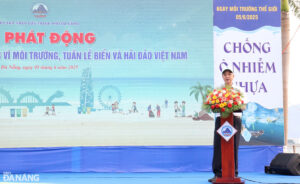Developing craft village-based tourism has been eyed as a direction for boosting socio-economic factors in many localities in the Red River Delta. However, such a model has not yet been well implemented, requiring a new approach in building a sound model which can preserve and promote the cultural values of traditional villages while facilitating tourism growth.

A foreign tourist tries her hands at making a conical hat at Chuong village in Phuong Trung commune, Thanh Oai District, Hanoi (Photo credit: Vu Quang Ngoc)
According to statistics from the Vietnam Craft Villages Association, Vietnam has over 5,400 trade villages, 40% of them being located in the northern region. Up to 1,500 of them are in Red River Delta, 300 of those having been recognised as traditional craft villages.
Throughout hundreds of years of history, the villages have served as places to practice and preserve traditional handicraft products imbued with the country’s cultural, architectural and aesthetic values. However, how to turn these values into attractive tourist products to attract visitors is a challenging puzzle which has faced villages for many years.
At the recent seminar entitled ‘Developing the models of craft village-based tourism and heritage village-based tourism in the Red River Delta’, which was jointly held by the National University of Civil Engineering, the Hung Yen Provincial Department of Culture, Sports and Tourism, and the People's Committee of Hung Yen province’s Van Lam district, participants reviewed the current situation and pointed out the reasons why tourism activities in traditional craft villages are not thriving.
According to Assoc. Prof. Pham Hung Cuong from the National University of Civil Engineering, one of the main reasons is that the craft villages have not made a thorough assessment on their potential for tourism development.
Tourism activities in these villages have just merely focused on inviting visitors to tour the villages rather than introducing them to their time-honoured cultural values.
In addition, the craft villages have not yet been active in working out new tourism products to serve tourists while seeking output avenues for their traditional craft products, making the tourism product system inadequate and less attractive. Consequently, there are no tourism products which are attractive enough to visitors, leading to the low volume in revenue from tourism.
Thus, Dr. Pham Hung Cuong stressed the need to systematically evaluate the advantages and disadvantages of the tourism development potential of craft villages, which will help to map out detailed action plans and design suitable development models for the villages.
He also called for a change in the method of evaluating the potential for tourism development in craft villages. Such potential not only includes the practice of the craft but also architectural and intangible cultural heritages.

A villager demonstrating how to make silk from silkworms at a cultural event held in Van Phuc silk village in Ha Dong district, Hanoi.
For instance, many traditional crafts in Van Phuc silk village, Huong Canh pottery village, and Chuong conical hat making village should be perceived as a “brand” to promote tourism. In addition to the villages’ cultural values, traditional art forms of the Red River Delta such as water puppetry and cheo (traditional opera) singing should be integrated to diversify the regional tourist products.
There are four groups of tourism products which can be developed in traditional craft villages, including products focussing on the crafts themselves (the history and production process), farm work (offering visitors a farming experience such as fish catching and vegetable picking), architectural and landscape heritage (communal houses, pagodas, temples, and ancient houses), and intangible cultural products (cuisine, performing arts, costumes, customs, and festivals).
Building different groups of tourism products can realise the dual goal of promoting traditional crafts and tourism while encouraging visitors to spend more time and money in craft villages.
It is also necessary to pay greater attention to integrating traditional craft villages in tours to localities in the region in order to ensure a sustainable source of visitors to the villages.
The shift from agriculture and handicrafts production to developing tourism in combination with cultural practices requires careful research to work out a proper model of development, investment and management.
Dr. Nguyen Thu Hanh, Chairwoman of the Scientific Union for Sustainable Tourism Development, emphasised that this process needs the close involvement of local authorities, who play a key role in raising awareness and motivating local people to become actors in the value chain. In addition, she stressed the need to strengthen coordination among managers, scientists, businesses and the people in the implementation of the model.
















